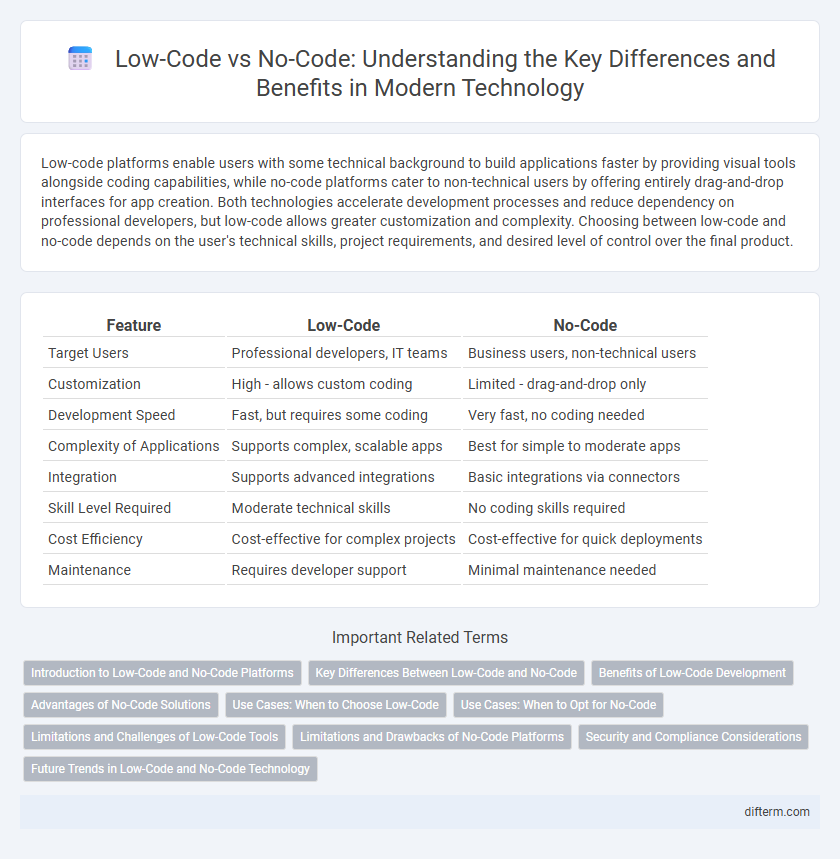Low-code platforms enable users with some technical background to build applications faster by providing visual tools alongside coding capabilities, while no-code platforms cater to non-technical users by offering entirely drag-and-drop interfaces for app creation. Both technologies accelerate development processes and reduce dependency on professional developers, but low-code allows greater customization and complexity. Choosing between low-code and no-code depends on the user's technical skills, project requirements, and desired level of control over the final product.
Table of Comparison
| Feature | Low-Code | No-Code |
|---|---|---|
| Target Users | Professional developers, IT teams | Business users, non-technical users |
| Customization | High - allows custom coding | Limited - drag-and-drop only |
| Development Speed | Fast, but requires some coding | Very fast, no coding needed |
| Complexity of Applications | Supports complex, scalable apps | Best for simple to moderate apps |
| Integration | Supports advanced integrations | Basic integrations via connectors |
| Skill Level Required | Moderate technical skills | No coding skills required |
| Cost Efficiency | Cost-effective for complex projects | Cost-effective for quick deployments |
| Maintenance | Requires developer support | Minimal maintenance needed |
Introduction to Low-Code and No-Code Platforms
Low-code and no-code platforms revolutionize software development by enabling users to create applications with minimal or no coding expertise, significantly accelerating project timelines. Low-code platforms offer visual development environments with pre-built components and allow some coding for customization, catering to both professional developers and business users. No-code platforms provide entirely drag-and-drop interfaces, empowering non-technical users to build functional applications without writing code, thus democratizing software creation.
Key Differences Between Low-Code and No-Code
Low-code platforms require some coding knowledge to customize applications, while no-code platforms enable users to build apps entirely through visual interfaces without writing code. Low-code offers greater flexibility and scalability suited for complex projects, whereas no-code prioritizes ease of use for rapid development by non-technical users. Key differences include target users, customization options, and deployment capabilities, with low-code bridging professional developers and citizen developers while no-code empowers business users.
Benefits of Low-Code Development
Low-code development platforms streamline application creation by enabling developers to use visual interfaces with minimal hand-coding, accelerating project delivery and reducing costs. These platforms enhance collaboration between IT teams and business users, improving customization and scalability for complex enterprise solutions. Low-code also supports integration with existing systems and facilitates easier maintenance, driving innovation and operational efficiency.
Advantages of No-Code Solutions
No-code solutions empower users with limited technical skills to build applications quickly through intuitive drag-and-drop interfaces, significantly reducing development time and costs. These platforms enhance business agility by enabling rapid prototyping and iterative changes without relying on specialized IT resources. By democratizing app creation, no-code tools facilitate increased collaboration between business users and developers, accelerating innovation and digital transformation.
Use Cases: When to Choose Low-Code
Low-code platforms are ideal for developers seeking to accelerate application development while maintaining customization capabilities, especially in complex enterprise solutions requiring integration with existing systems. Use cases include building scalable business process management tools, customer relationship management (CRM) systems, and custom workflows where precise control over logic and data models is essential. Organizations aiming for rapid deployment without sacrificing flexibility often choose low-code to balance speed and technical depth.
Use Cases: When to Opt for No-Code
No-code platforms are ideal for non-technical users seeking to build simple applications, such as event management tools, basic websites, and internal workflows, without needing programming skills. These platforms accelerate deployment for small businesses and startups by enabling rapid prototyping and iterative improvements. When customization demands are minimal and speed is crucial, no-code solutions offer a cost-effective alternative to traditional development or low-code approaches.
Limitations and Challenges of Low-Code Tools
Low-code platforms often face limitations such as reduced flexibility for complex customization, potential vendor lock-in, and scalability challenges when handling large enterprise applications. Security risks and integration difficulties with legacy systems can also hinder deployment in highly regulated industries. Developers may encounter a steep learning curve to optimize these platforms effectively, constraining their ability to fully leverage low-code solutions in mission-critical scenarios.
Limitations and Drawbacks of No-Code Platforms
No-code platforms often face limitations in customization and scalability, restricting complex application development and integration with legacy systems. They can lead to vendor lock-in due to proprietary frameworks and limited export options, complicating migration and long-term maintenance. Performance issues may arise from platform constraints, impacting responsiveness and security in enterprise-grade applications.
Security and Compliance Considerations
Low-code platforms offer enhanced customization options enabling organizations to implement specific security protocols and ensure compliance with industry standards such as GDPR and HIPAA. No-code solutions, while user-friendly, may present challenges in granular control over data encryption and access management, potentially increasing risk exposure. Careful evaluation of each platform's security frameworks and compliance certifications is critical to mitigate vulnerabilities and align with regulatory requirements.
Future Trends in Low-Code and No-Code Technology
Low-code and no-code platforms are driving the future of software development by enabling faster application delivery and expanding access to non-technical users. Emerging trends include the integration of AI-powered automation and advanced analytics, which enhance customization and scalability within these environments. The adoption of these technologies is projected to accelerate digital transformation across industries, reducing dependency on traditional coding expertise.
Low-Code vs No-Code Infographic

 difterm.com
difterm.com